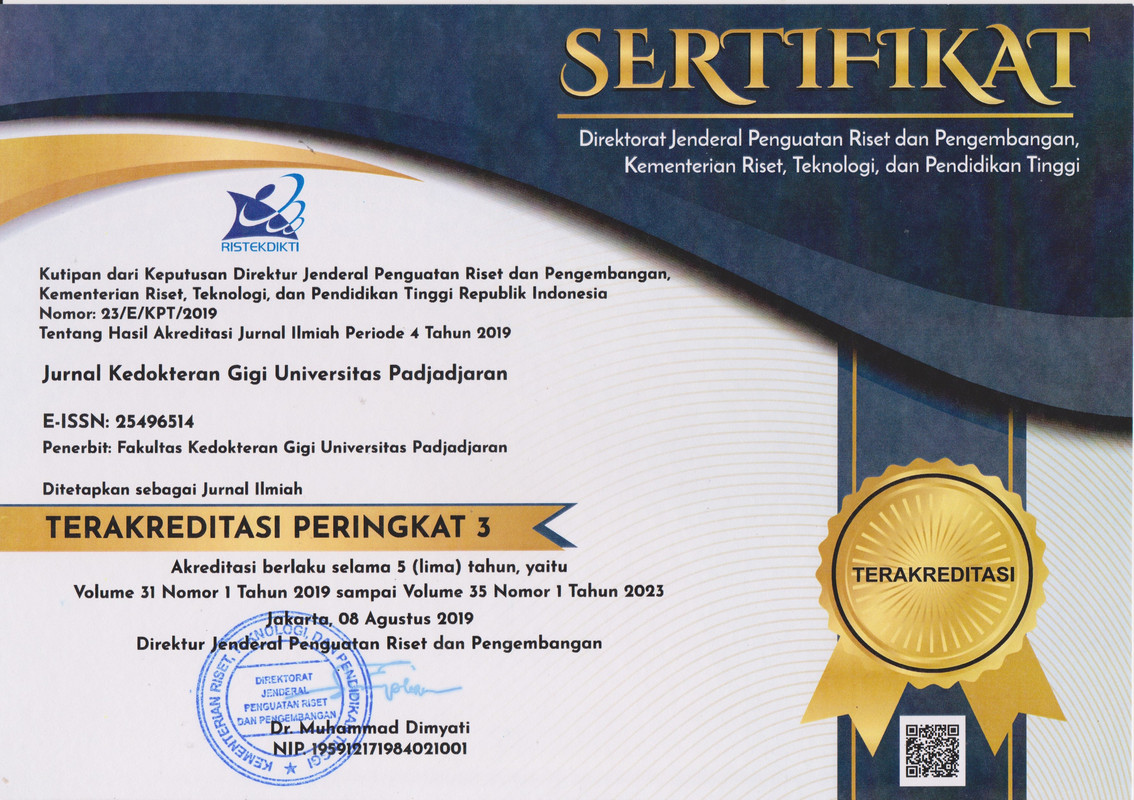Pengaruh jumlah glass fiber non dental pada reinforced resin akrilik (polimetil metakrilat) terhadap perlekatan Candida albicans
Effect of the concentration of non-dental glass fiber on reinforced acrylic resin (polymethyl methacrylate) on the attachment of Candida albicans
Abstract
Pendahuluan: Glass fiber non dental merupakan bahan yang digunakan sebagai penguat gipsum dan komponen otomotif dengan komponen yaitu Na2O dan K2O dapat meningkatkan ketahanan terhadap asam dan meningkatkan penyerapan air. Glass fiber non dental banyak tersedia di Indonesia dengan harga yang terjangkau dapat menjadi alternatif pengganti dari E-glass fiber dental yang ketersediaannya terbatas di Indonesia dan harga relatif mahal. Tujuan penelitian adalah menganalisis pengaruh jumlah glass fiber non dental pada reinforced resin akrilik terhadap perlekatan C.albicans. Metode: Jenis penelitian yaitu Eksperimen laboratorium dengan rancangan Posttest Control Group Design yang dilakukan untuk mengetahui pengaruh jumlah glass fiber non dental pada reinforced resin akrilik terhadap perlekatan C. albicans dengan 12 sampel yang dikelompokkan menjadi 3 kelompok yaitu glass fiber non dental 0,9 %, glass fiber non dental 1,8 %, dan tanpa fiber. Analisis statistik menggunakan uji Oneway ANOVA dengan nilai p < 0,05. Hasil: penelitian menunjukkan bahwa glass fiber non dental 0,9 % ( hasil rata-rata: 1,10), glass fiber non dental 1,8 % (hasil rata-rata: 1,125), dan tanpa fiber (hasil rata-rata: 1,525) memiliki efek berbeda tetapi tidak bermakna. Simpulan: Penambahan glass fiber non dental pada lempeng resin akrilik tidak berpengaruh terhadap perlekatan C. albicans.
Kata kunci: Glass fiber non dental, fiber reinforced resin akrilik, Candida albicans
ABSTRACT
Introduction: Non-dental glass fiber is a material used as gypsum reinforcement and automotive components with components namely Na2O and K2O can increase acid resistance and increase water absorption. Non-dental glass fiber is widely available in Indonesia at an affordable price can be an alternative substitute for E-glass dental fiber whose availability is limited in Indonesia and the price is relatively high. The purpose of this study was to analyse the effect of the amount of non-dental glass fiber on reinforced acrylic resin on the attachment of C. albicans. Methods: This type of research is a laboratory experiment with a Posttest Control Group Design that was conducted to determine the effect of the number of non-dental glass fiber on reinforced acrylic resin on the attachment of C. albicans with 12 samples grouped into 3 groups, namely 0.9% non-dental glass fiber, non dental glass fiber 1.8%, and without fiber. Statistical analysis using the Oneway ANOVA test with a p-value <0.05. Results: The study showed that non-dental glass fiber was 0.9% (average yield: 1.10), non-dental glass fiber was 1.8% (average yield: 1,125), and without fiber (average yield: 1,525) has a different but not significant effect. Conclusion: Addition of non-dental glass fiber to acrylic resin plates did not affect the attachment of C. albicans.
Keywords: Non-dental glass fiber, fiber-reinforced acrylic resin, Candida albicans
Keywords
Full Text:
PDFDOI: https://doi.org/10.24198/jkg.v31i2.23450
Refbacks
- There are currently no refbacks.
Copyright (c) 2019 Jurnal Kedokteran Gigi Universitas Padjadjaran
INDEXING & PARTNERSHIP

Jurnal Kedokteran Gigi Universitas Padjadjaran dilisensikan di bawah Creative Commons Attribution 4.0 International License






.png)
















